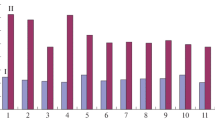Abstract
KB-26.5, a murine hybridoma cell line producing an IgG3 monoclonal antibody used in blood type determination, primarily adapted to grow at 5% foetal calf serum (FCS) concentration has been adapted to grow at 0.5% FCS, maintaining its ability to produce antibodies at the same level. In the final step of adaptation, the addition of insulin, transferrin, ethanolamine and selenium to the media formulation was studied, using factorial assay techniques to check the effect of the different compounds and to optimize their required level for satisfactory growth and antibody secretion. KB-26.5 cells required only 20 μg/ml of transferrin to adapt to 0.5% FCS medium. Furthermore, transferrin could be substituted by FeCl3, at a relatively low level of 2 μg/ml. Maximum cell density decreased by 31.5% in spinner flask test, but the antibody titer was maintained, thus the specific productivity increased. However, inoculum size had to be increased three-fold with 0.5% FCS medium in order to assure cell growth.
Similar content being viewed by others
References
Blasey HD and Winzer U (1989) Low protein-free medium for antibody-production in stirred reactors. Biotechnol. Lett. 11: 455–460.
Cleveland WL, Wood I and Erlanger BF (1983) Routine largescale production of monoclonal antibodies in a protein-free culture medium. J. Immunol. Methods 56: 221–234.
Cole SPC, Vreeken EH and Roder JC (1985) Antibody production by human x human hybridomas in serum-free medium. J. Immunol. Methods 78: 271–278.
Ekblom P, Thesleff I, Saxen L, Miettinen Aa and Timpl R (1983) Transferrin as a fetal growth factor: acquisition of responsiveness related to embryonic induction. Proc. Natl. Acad. Sci. 80: 2651–2655.
Farrant J, Newton CA, Weyman C and Brenner MK (1984) Production of antibody by human B cells under serum-free conditions. J. Immunol. Methods 68: 25–34.
Fazekas de StG S and Scheidegger D (1980) Production of monoclonal antibodies: strategy and tactics. J. Immunol. Methods 35: 1–21.
Fazekas de StG S (1983) Automated production of monoclonal antibodies in a cytostat. J. Immunol. Methods. 57: 121–136.
Franek F and Dolníková J (1991) Hybridoma growth and monoclonal antibody production in iron-rich protein-free medium: effect of nutrient concentration. Cytotechnology 7: 33–38.
Glassy MC, Tharakan JP and Chau PC (1988) Serum-free media in hybridoma culture and monoclonal antibody production. Biotechnol. Bioeng. 32: 1015–1028.
Guilbert LJ and Iscove NN (1976) Partial replacement of serum by selenite, transferrin, albumin and lecithin in haemopoietic cell cultures. Nat. 263: 594–595.
Hamilton TA, Wada HG and Sussman HH (1979) Identification of transferrin receptors on the surface of human cultured cells. Proc. Nat. Sci. 76: 6406–6410.
Hayter PM, Kirby NF and Spier RE (1992) Relationship between hybridoma growth and monoclonal antibody production. Enzyme. Microb. Technol. 4: 454–461.
Hofeld JT and Oppenheim JJ (1980) Enhancement of the primary antibody response by β-mercaptoethanol is mediated by its action on glutathion in the serum. Eur. J. Immunol. 10: 391–395.
Holley RW (1972) A unifying hypothesis concerning the nature of malignant growth. Proc. Nat. Sci. 69: 2840–2841.
Hutchings SE and Sato GH (1978) Growth and maintenance of HeLa cells in serum-free medium supplemented with hormones. Proc. Nat. Sci. 75: 901–904.
Karin M and Mintz B (1981) Receptor-mediated endocytosis of transferrin in developmentally totipotent mouse teratocarcinoma stem cells. J. Biol. Chem. 256: 3245–3252.
Kovár J and Frantisek F (1987) Iron compounds at high concentrations enable hyridoma growth in a protein-free medium. Biotechnol. Lett. 10: 259–264.
Raurell CB (1960) Metal binding plasma proteins and cation transport. In: Putnam FW (ed). The Plasma Proteins. New York, Acad. Press.
Litwin J (1989) The growth of hybridoma cells in a serum- and protein-free medium. Esact Conference 273–276.
Low K and Harbour C (1985) Growth kinetics of hybridoma cells: (1) the effects of varying foetal calf serum levels. Develop. Biol. Standard. 60: 17–24.
Maurer HR (1986) Towards chemically-defined, serum-free media for mammalian cell culture. In: Freshney RI (ed). Animal Cell Culture a Practical Approach (pp. 13–31). Oxford, Washington DC, IRL Press.
Pérez-Infante V and Mather JP (1982) The role of transferrin in the growth of testicular cell lines in serum-free medium. Exp. Cell. Res. 142: 325–332.
Shacter E (1989) Serum-free media for bulk culture of hybridoma cells and the preparation of monoclonal antibodies. Trends Biotechnol. 7: 248–253.
Shinmoto H, Dosako S and Taneya S (1991) Long-term culture of mouse hybridoma HB8852 cells in a protein-free medium. Biotechnol. Lett. 13: 683–686.
Willmer EN (1960) Tissues in culture and in the body. Symp. Soc. Exp. Biol. 14, 28.
Author information
Authors and Affiliations
Rights and permissions
About this article
Cite this article
Damgaard, B., Sanfeliu, A., Cairó, J.J. et al. Substitution of transferrin by FeCl3 in the development of a low foetal calf serum concentration medium for KB-26.5 hybridoma cell line. Cytotechnology 13, 133–141 (1993). https://doi.org/10.1007/BF00749940
Received:
Accepted:
Issue Date:
DOI: https://doi.org/10.1007/BF00749940




